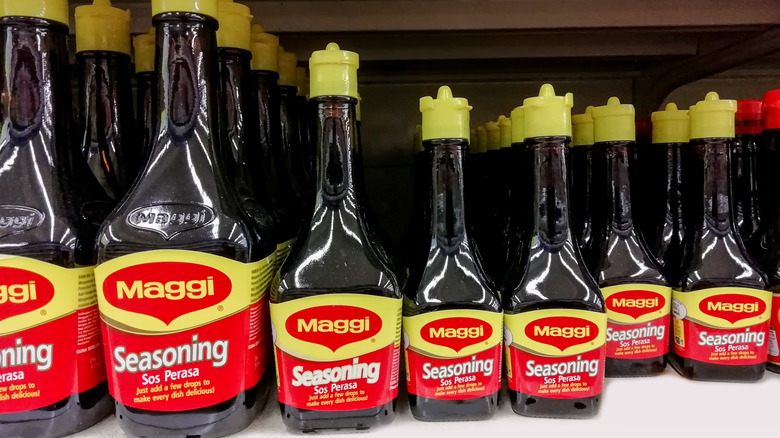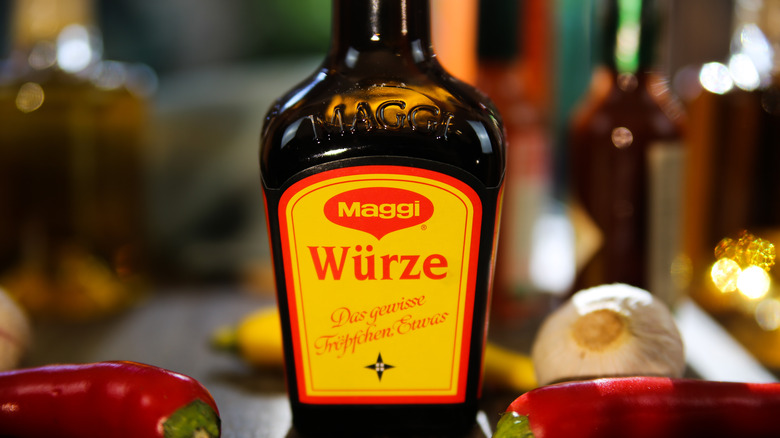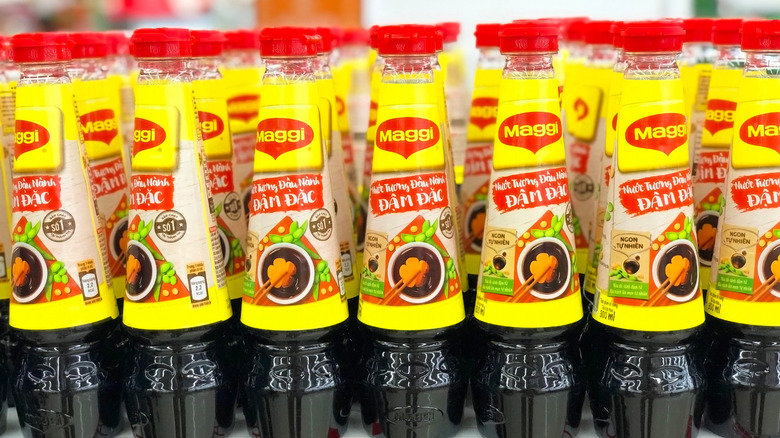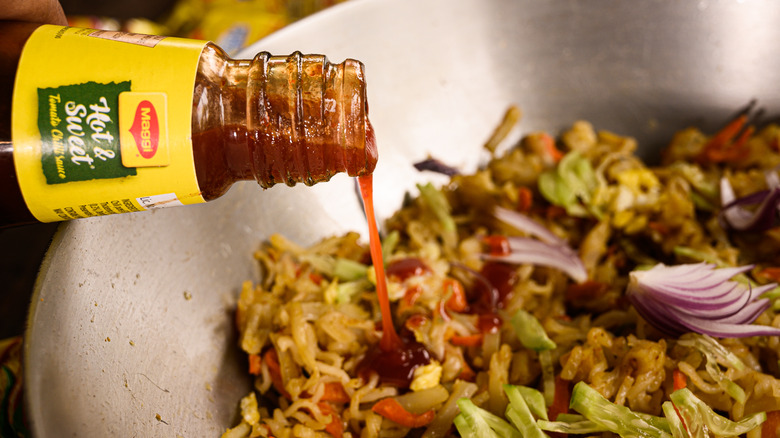Switzerland's Maggi Seasoning Transcends Culinary Borders
For more than 100 years, bottles of Maggi liquid seasoning have been used to add flavor to a variety of dishes the world over. It's easy to spot a container of Maggi no matter what country you're looking to buy it in because of its signature brown bottle and yellow label. However, the color of the cap is generally one of two colors: red in Switzerland, Germany, Canada, and France or yellow in the U.S., China, and the Netherlands (via The Spruce Eats). While easy to identify by its appearance, it's not as easy to describe Maggi's flavor. It is often described as having a rich, savory umami taste with some saltiness.
When comparing Maggi to other condiments, it often gets grouped together with soy sauce. And like soy sauce, it doesn't need to be refrigerated but simply should be kept in a cool and dry place, making it an easy grab for home and professional cooks looking to enhance the flavor of whatever they are making, from soups to sauces and Asian noodle dishes to Mexican tacos.
A European creation
Maggi seasoning has a long history in Europe, having been created in 1886 by Julius Maggi, a Swiss inventor, according to Nestlé. Before there was Maggi seasoning, the company developed inexpensive yet nutritious foods with vegetables for the working class after receiving a contract to do so from the Swiss government (via Spiceography). One of the main innovations of Maggi was instant soups.
The company originally began producing the liquid seasoning blend in Germany in 1886, with the name of Maggi Würze. Würze means spice or seasoning in German, according to The Spruce Eats. This seasoning blend was dark in color and contained hydrolyzed vegetable proteins. Like the instant soups and vegetable-based flours that Maggi created, the seasoning blend also appealed to the working class because it could serve as a substitute for a meat extract, such as meat broth, yet was less expensive.
As the seasoning grew in popularity, it was distributed in different countries around the world, where the flavor was slightly changed to suit local tastes. Although Maggi started as an independent company in Europe, it was bought by Nestlé in 1947. Maggi still operates as a division of Nestle.
Nine flavor formulations
Maggi seasoning has found customers in geographically very different areas of the world with very different cuisines, including Africa, the Middle East, Mexico, and the Philippines, resulting in the creation of nine different Maggi varieties, per The Spruce Eats. Each formulation has a slightly different taste to reflect the country's cuisines and flavor preferences. According to Bon Appétit, the Filipino version of Maggi seasoning has a stronger taste of garlic, while the version sold in Mexico has a more intense flavor.
When the bottles of seasoning are marketed in different countries, not only do their recipes change but so do the names. In Mexico, it's known as Jugo Maggi, per Eater, but it is called Maggi Savor in the Philippines. There's a second version available in the Philippines called Savor Calamansi, which tastes of tart citrus. The original Swiss-German product tastes highly of vegetables, per Bon Appétit, and according to the Maggi website, has a "strong aromatic liquid flavouring." Something else that differentiates the different versions of Maggi seasoning is if it has MSG added. While most countries' versions of Maggi do contain MSG, the version sold in the United States does not (via Eater).
A flavor enhancer for a variety of cuisines
While Maggi may be compared to other common condiments, such as Worcestershire sauce or soy sauce, it has its own unique flavor. Dark in color like Worcestershire sauce and soy sauce, Maggi doesn't have the sweetness of Worcestershire and has a more complex flavor than soy sauce. Bon Appétit describes the flavor of Maggi as being smoky and tasting of roasted vegetables and meat. With a salty, umami flavor, it's also compared to marmite.
Bon Appétit emphasizes that the Mexican version of Maggi seasoning is well-suited for use with seafood, such as Baja-style ceviche, or with chiles güeros or tacos. However, Maggi tastes good on a variety of international foods, such as stir-fries and noodle- and rice-based dishes. Eater also highlights just how many foods Maggi complements, including steamed greens, soups, stews, stocks, bloody Marys, pickling liquids, and marinades. Or even use it as a substitute for fish sauce when a meat-free version is preferred. A little bit goes a long way when it comes to Maggi. The Spruce Eats advises that sometimes only a drop or two needs to be added to soups, sauces, stews, eggs, and other recipes to enhance the existing flavors. In addition to having a fairly condensed flavor, Maggi is salty, so it's best to go easy with adding it to dishes.



